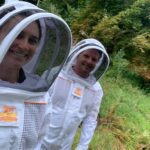Alan & Alanna Daly
Alan & Alanna are a father-daughter duo who are the 4th and 5th generation on their farm situated alongside Lough Mask, Co. Mayo. They farm over 200 hectares (500 ac), carrying 340 sheep and 60 Angus and Galloway cattle.
Half of their farm is in native woodland that hasn’t been touched in 200 years. Their whole outlook revolves around working with nature ‘ we don’t interfere with nature here, we’re not enemies’. Their woodland hosts red squirrels, pine marten, stoats, and a whole range of lichens.
Six hectares of their land is sown with wildflowers, and they have a wildlife pond where ducks and herons are regular visitors. They’ve built a bat roost, which is the home of a family of Lesser Horse-Shoe bats. As a means of reseeding their fields, they lay cut hay out for wildflower seeds to embed themselves in.
In organic conversion, their only inputs are lime and potash, which they spread on one field per year. They are hoping to plant up 4 hectares of agroforestry this year, as a means to create wildlife corridors on their land between habitats. Their vision for the future is ‘if we manage the farm the same way it has been managed for the past 100 years everything will be fine’.
NOMINATOR: Barry O' Donoghue, National Parks and Wildlife Service
NOMINATION:
Alan and Alanna Daly are father and daughter, the 4th and 5th generation of Daly’s working together at Lough Mask House farm. They joined the organic scheme in the spring of 2022 and have worked with the NPWS and ecologists Tom O’Donnell and Eamonn Delaney, on an ambitious and large-scale NPWS farm plan that is putting nature at the centre of Alan and Alanna’s thinking when it comes to managing the land. The interest and enthusiasm that the Daly’s have for nature is a joy to behold.
They have sheep and suckler cows and sell lambs and weanlings. The farm, which extends over 200 hectares, is half grasslands and half ancient woodlands. The grasslands have 6 hectares of wildflower meadows and it is planned to convert 4 hectares of grassland to agroforestry this spring.
Because of the biodiversity friendly management of the land extending back generations, the farm is a hotspot for biodiversity; particularly the woods, which include bats, deer, red squirrels, foxes, pine martens and more.
The Daly’s have facilitated different ecological studies on their land, including research on pine martens and stoats and bats.
Through the NPWS Farm Plan Scheme, Alan and Alanna have further enhanced the biodiversity of the farm by renovating a derelict building so that a maternity colony of Lesser Horseshoe Bat can safely return to their historical roosting site. They have also carried out grassland habitat enhancement works including fencing to give greater control of grazing, hedgerow planting, establishment of wildflower meadows from the soils existing seedbank. Other grassland enhancement works include physical bracken control where it is encroaching onto semi-improved grassland. As part of the farm plan, they have fenced off a localised wetland habitat and its wetland fringe, which has seen the establishment of a tall herb wetland vegetation and its continued use by wildfowl. The Daly’s are conscious of keeping local water clean and organic methods, avoiding chemicals help with this.
The woodlands are rich in various native Irish trees including oak, willow, alder, ash, hazel, holly , lichen, fungi and a rich bryophyte layer. The farm also fringes the shores of Lough Mask, and supports seasonally inundated calcareous wet grassland occurring in mosaic with limestone outcrops.
The semi-natural wildflower meadows have various species, including grasses such as crested dog’s tail, common bent, red fescue, glaucous sedge and sweet vernal grass, in addition to broadleaved herbs such as self heal, ox eye daisy, ladies bedstraw, autumn hawkbit, yarrow, Cat’s-ear and lesser stitchwort. Ongoing grazing and mowing management of these meadows over the short term could result in their correspondence with the Annex I grassland habitat ‘Lowland Hay Meadows 6510’. In 2023, Alan and Alanna set up beehives for native Irish honeybees who forage for nectar in our wildflower meadows and woodlands.
Mar fhocal scoir, it is always heartening to see young farmers taking on the challenge of managing for the environment, while learning from old ways as well as new. Alanna and Alan certainly inspire in this regard.











